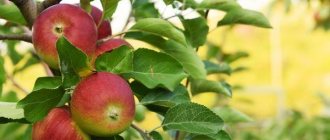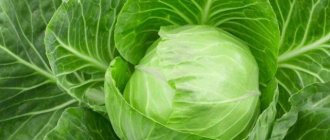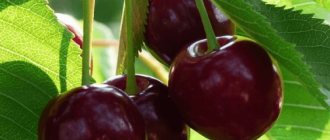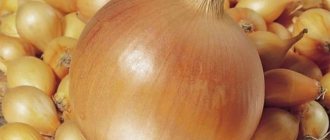Our country is famous for fruit trees of domestic selection, but in Russian dachas there are also many varieties bred by foreign scientists. Today we will introduce readers to one of these plants - the Lobo apple tree, and talk about its features and positive qualities that attract the attention of gardeners.
The Lobo apple tree (pictured) produces a large harvest of fruits intended for consumption in winter
Description of the variety with photo
The apple tree is relatively small, up to four meters in height . The variety is zoned for central Russia, but in fact it grows well in both the northern regions and the south of the country. So, in the Moscow region this variety can be found in every fifth dacha.
In the State Register, the variety is marked as winter, but it would be more correct to consider it as autumn-winter , since over time the characteristics of winter varieties have changed somewhat.
Interesting! Winter varieties usually include plants whose fruits are stored throughout the winter. Lobo apples lose their quality after just three months of storage.
Lobo is unpretentious and bears fruit well even with minor inaccuracies in care . Growing this variety does not require scrupulous adherence to agricultural technology from the gardener.
Ripening and fruiting of Lobo
Beginning of fruiting
The variety is usually classified as early-fruiting. You can start harvesting the first fruits 3-4 years after planting. Of course, you can’t count on a large harvest, but 15-20 kilograms is quite possible. The main thing is to completely cut off the flowers from the first year if they appear on the branches in the spring.
Flowering time
Mostly in the middle zone, the variety begins to bloom in the middle or end of May. It lasts approximately 12-16 days, during which the bees manage to do their work. But in bad weather or in colder climates, flowering may be delayed and even begin in early June.
The flowers of the apple tree are medium-sized, beautiful, always very abundant, fragrant, white or with a slight pink tint. After 10-12 years, it is necessary to regulate their quantity (cut off by about one third), otherwise the crop will become smaller and degenerate, and the tree will stop bearing fruit quite soon, in 30-35 years.
Fruiting and growth
Before fruiting begins, trees of this variety grow simply before our eyes. They can expel more than 60-70 centimeters per season. However, after they begin to bear fruit, this process slows down somewhat, by about 25-30%. The increase in yield occurs smoothly, but like an avalanche; every year there are more and more fruits and already by 7-8 years it is possible to harvest an almost full-fledged harvest.
It is customary to remove apples from the branches no earlier than the middle, or even better, the end of September. True, in more northern regions they ripen only in October. There is no need to worry that the fruits will fall to the ground; they stick very tightly to the branches and, if they fall off, this is a clear sign of illness. In a properly equipped cellar, apples can be stored until spring, or even until a new harvest, with almost no loss of taste and commercial qualities, for which the variety is so highly rated by industrial producers.
Top dressing
- Chicken droppings.
- Mineral complexes.
- Wood ash.
- Humus.
- Compost.
- Ammonium nitrate.
- Manure.
What to do if it doesn’t bloom or bear fruit
- Provide moisture.
- Check for pests and diseases.
- Replant to a sunnier location.
- Limit watering.
Characteristics
| Characteristic | Description |
| Tasting assessment | Professionals rate the taste of the fruit as 4.8 on a 5-point scale. The apple pulp is described as juicy, fine-grained, not prickly, but still crisp. The color of the pulp can vary from soft cream to light lemon or pink. The fruits have a powerful, clearly distinguishable fruit and berry aroma. |
| Crown and root system | The crown is wide-round, pyramidal or oval in shape, not prone to excessive thickening, which greatly facilitates harvesting. In old trees, there is some sagging of the branches, due to which the crown acquires a weeping outline. The root system is not too powerful, moderately branched, not very deep. Depending on the rootstock on which the apple tree is grafted, the root may or may not have a central core. |
| Productivity | Lobo is considered a high-yielding variety: with proper care, it is possible to harvest up to 200 kg of beautiful fruits per season from an adult tree. |
| Self-fertility, pollinators | The apple tree is conditionally sterile, and to produce a harvest it requires the presence of pollinating trees on the site. For cross-pollination, gardeners plant Spartan, March or Orlik varieties together with lobo. |
| Winter hardiness | The apple tree is considered very hardy and can withstand even harsh winters. |
| Frost resistance | The frost resistance of the variety will largely depend on the rootstock on which the lobo scion is located. But the maximum negative temperatures that the tree can withstand without damaging the bark are recorded around -32 °C. |
| Drought resistance | It is highly resistant to short-term droughts. |
| Harvest ripening and storage | Apples ripen in October, this happens almost simultaneously for the entire harvest. You can store apples without loss of taste for no more than 2.5–3 months. |
| Resistance to diseases and pests | Unfortunately, lobo is not resistant to scab and powdery mildew, which is why it is necessary to regularly carry out preventive treatments of the crop. |
Advantages and disadvantages of the variety
The variety has plenty of advantages.
The main positive aspects are:
- high decorative qualities of wood;
- abundant and regular harvests;
- excellent taste of fruits and their simultaneous ripening;
- high frost and drought resistance.
But it would be wrong not to note a number of disadvantages inherent in the variety :
- low resistance to apple scab;
- in unfavorable weather conditions in spring, fruits set poorly;
- apples have a short shelf life;
- in extreme heat it tends to shed leaves and part of the crop.
Reviews from gardeners
Evgenia, 46 years old, Saratov region
I have long wanted to buy a couple of seedlings on dwarf rootstocks in order to try to form trees on flat trellises. Finally, I chose the Lobo apple trees: the photo of the bright crimson fruits was especially impressive, and the detailed description gave me some confidence that I could handle it. I placed both seedlings on the border of the garden and the recreation area, and from the next spring every year I purposefully trimmed the skeletal branches and attached them to the trellises. Apart from these works, there were no special difficulties in care. Now my babies are 4 years old, last fall I picked the first apples (not many yet). I’m very pleased with the taste of the fruits, and the apple trees growing on the trellises are so beautiful that it’s hard to describe.
Nikolay, 68 years old, Tver
On our site, the apple tree of this variety is old - it is more than 25 years old. I have never failed with the harvest: there have been more and less bountiful years, but I don’t remember any “empty” ones. Fiddle with it quite a bit. The crown of the tree is quite sparse by nature and requires almost no special shaping. But you need to spray for scab and powdery mildew every year, otherwise the fruits will be seriously spoiled. Apples have an extraordinary taste: sweet, soft, tender. The aroma is either honey or candy. If they are removed by hand at the end of September and stored correctly, they remain tasty for three months. So, they sometimes appear on our New Year’s table (if the grandchildren don’t eat them first). An excellent variety, tasty, productive and practically problem-free.
Andrey, 45 years old, Perm region
We have big problems growing late varieties of apple trees, especially when their fruit ripening period is extended. Therefore, I chose Lobo for myself and over several years formed a tree in a creeping form. As a result, despite our harsh winters, the roots were never damaged. I try to cover the entire crown with snow, since young branches left without shelter sometimes freeze. Fortunately, the variety turned out to be very tenacious - the tree quickly recovers and continues to bear fruit. It is safe to say that this apple tree can be grown in difficult climatic conditions.
Comparison of lobo with other varieties
The lobo apple tree is often compared to other varieties of fruit crops. The main competitors of the variety are usually called the following:
- fetch;
- candy
Comparative characteristics
| Characteristic | Lobo | Aport | Candy |
| Variety | Autumn-winter | Early winter | Summer |
| Fruit | Green-yellow with large red blush | Green-yellow with pink blush | Yellow with a reddish tint |
| Taste | Sweet and sour | Sweet | |
| Weight | Up to 200 g | 230 g | 100 g |
| Winter hardiness and frost resistance | High | Average | High |
| Disease resistance | Affected by scab, fruit rot and powdery mildew | Susceptible to scab development | Sick of scab |
| Productivity | High | Average | |
| Transportation of fruits | Apples tolerate transportation well | Fruits do not tolerate transportation well | |
| Harvest storage | Up to 3 months without loss of quality | Up to six months | Just over a month |
| Application of fruits | Apples are suitable for consumption fresh, canned and dried. | Apples are eaten fresh and canned. | |
Description of the berry
The fruits are distinguished by their delicate aroma, pleasant taste and beautiful appearance. The size of the fruit is from 100 to 180 g. The structure of the apple is round, slightly compressed. The color of the shell is dark crimson. Approximately half the surface of the fruit is covered with an intense waxy layer.
The pulp is aromatic, tender, white. The taste of the apple is sweet with a slight hint of sourness. The skin is very thin. Fruits ripen closer to October.
The fruits have good shelf life (stored until the first month of the next year) and are not afraid of long-term transportation.
Types of rootstocks
The crop is grown on different rootstocks . Some characteristics of the tree will depend on which rootstock is chosen for grafting.
Dwarf
Grafted onto a dwarf rootstock, Lobo b will differ only in its size . The maximum tree height is set to 3 meters. The shape of the crown does not differ, it will only have a more compact size.
Semi-dwarf
Such plants are recommended for growing in small areas . The size of the crop is small, and it will begin to bear fruit already 3 years after planting.
Columnar
Farmers prefer to grow the columnar form, since the size of the plant allows a larger number of seedlings to be planted in a limited area . The height of the apple tree does not exceed 2 meters, and there are no skeletal branches.
Stlantsevy
This is a creeping variety with compact dimensions: a creeping lobo will take up no more space on the site than its standard form . A distinctive feature of this form of tree will be less susceptibility to disease and excellent frost resistance.
Interesting! In Siberia and the Urals, lobo is most often grown in its stale form.
Description of the tree
The tree is relatively tall, reaching 4 meters. Young plants, up to 3 years old, rapidly gain height. After overcoming the 3-meter bar, the growth rate slows down. The crown of a young tree is vertically oval; in an adult tree that bears fruit, it becomes rounded.
Young shoots are of medium thickness, covered with small lentils. The size of the leaves is medium, the type of structure is oval. The leaf shape is heart-shaped with a curled tip. The color of the leaf plate is green, the surface is matte.
The tree has average frost resistance. Branches grafted into the crown can retain fruit buds even after severe cold, and then produce an excellent harvest.
The ideal way to grow the Lobo variety is by grafting onto a winter-hardy rootstock.
Features of growing lobo
The apple tree is unpretentious and does not have specific requirements for planting and care, which is why novice gardeners love it so much.
Growing conditions
Much of your success when growing an apple tree will depend on choosing the right site. You should not plant an apple tree in lowlands and shaded areas. For successful fruiting, choose open, well-lit places with light shading during the midday heat .
Try to provide loose, nutritious soil for the apple tree. But with proper preparation (adding sand, peat, humus), lobo can also be grown on heavy soils.
This is also true for sandy soils. If you add chernozem and compost into the planting hole, the apple tree will feel quite comfortable.
Disembarkation dates
The main criteria for choosing a planting date are the time when the seedling is at rest.
In spring, planting is carried out before the sap begins to flow, but after the frosts have passed.
In autumn - at least 2 weeks before the onset of cold weather.
Landing
For planting seedlings, a pit is prepared 2–3 months in advance - a large one, about 1x1 meter and about 0.8 m deep . A drainage layer of expanded clay, small pebbles or broken brick is laid at the bottom.
Pour a prepared nutrient mixture of fertile soil, humus, peat, 1 kg of superphosphate and the same amount of wood ash on top.
The substrate is thoroughly mixed and poured into the hole in a heap. Having retreated from the center, they drive in a support stake, to which the seedling is subsequently tied.
A tree is planted on a hill of substrate, the roots are straightened and the hole is filled with soil. The earth around the seedling is slightly compacted and mulched. Plantings are watered abundantly.
Protection from frost and rodents
Despite their high frost resistance, young plants must be insulated for the winter. To do this, leaf litter and old mulch are removed from the tree trunk circle. The soil is loosened, re-mulched and covered with straw mats.
Important! The trunk of young apple trees is not whitened - this can damage the delicate bark.
Instead of whitewashing, young seedlings are tied with spruce branches or straw mats . This measure will save the tree not only from frost, but also from rodent attacks.
Landing
As noted above, the Lobo apple tree needs good care. But first, she needs to be planted.
To do this, you must first prepare the seat. In the area where it is planned to plant a tree, all weeds are completely removed. When the land is cleared, the soil is dug up and fertilizer is added to it. This arrangement would be ideal:
- 5-8 kg of compost;
- 6-8 kg of peat;
- 50 g potassium salt;
- 100 g superphosphate;
- 40 g of potassium sulfate.
If the selected area has a high level of soil acidity (around 5-6 pH), then it is necessary to extinguish it with lime. For this, either dolomite flour or calcareous tuff is used. At the same time, pay attention to the fact that if you previously fertilized the soil with manure or phosphates, they will lose their strength due to interaction with lime.
A hole is dug approximately 80-100 cm deep. The width of the hole is about 70-100 cm. If the soil is fertile, then you can dig a hole as deep as the root system; if not, deeper to apply fertilizer.
The landing process is as follows:
- When we dig a hole, we first remove the top layer of soil and place it separately. This is the most fertile layer. After the hole is ready, put it on the bottom and add wood ash (1 kg) and 2 kg of humus to the hole.
- The description of the variety says that the Lobo apple tree is relatively small, so when planting a garden, the trees are placed at a distance of 4-5 m from each other.
Tree care
Lobo is one of those varieties that readily forgive gardeners minor mistakes in care. But a number of standard activities still need to be performed.
Loosening the soil and watering
Young trees are watered moderately but regularly, avoiding stagnation of moisture in the soil . Mature trees do not require such thorough irrigation; it is enough to water them only 4 times per season.
It is necessary to loosen the soil in the tree trunk circle after each watering or precipitation; You can combine the procedure with weeding. Regular loosening helps to avoid the formation of a hard, airtight crust on the soil surface .
Top dressing
In the first 2 years after planting, there is no need to feed the seedlings, since all the necessary nutritional components are included during planting. Starting from the 3rd year of life, the culture requires mineral support . Lobos are fed with both mineral complexes for fruit plants and organic matter (slurry and bird droppings.
Attention! The apple tree also responds well to the addition of compost to the tree trunk.
Crown formation and anti-aging pruning
Every year the apple tree is subjected to formative and sanitary pruning . First of all, the tree is inspected for damaged and broken branches and removed.
Then the young shoots are shortened by a third of the total length and the crown is thinned, thereby shaping it.
Planting and preparation for it
The correct technology for planting a plant and choosing a place of growth are the most important factors influencing its further development. Read below about the timing of planting an apple tree in the soil, as well as the rules for choosing a seedling.
Important! When planting fruit crops, it is necessary to adhere to the planting pattern - 3 m between trees and 2.5 m between rows.
Optimal timing
If the crop is planted in regions with a warm climate, planting is carried out in the fall so that the seedling begins its active growth in the spring. Autumn planting takes place from late September to mid-October.
In the conditions of northern cold, the best thing to do is to plant the plant in the spring - then the root system will have time to get stronger before the winter cold, and the trunk and branches will stock up on nutrients. Spring planting of seedlings in the ground takes place at the end of April.
Choosing the best seedling when purchasing
When purchasing a seedling, you must pay attention to the graft mark, which will be evidence of the authenticity of the variety. It is best to choose 1-2 year old seedlings with well-developed rhizomes. The plant should not have diaper rash or dry twigs. The roots must be free of rot, at least 35 cm in length, and the seedling itself must be at least 1 m.
Choosing a place to plant an apple tree
Apple trees are planted in spacious, well-lit areas. However, you should not plant a fruit tree in an area where there is a strong draft, because such a phenomenon will provoke the transfer of pests and fungal spores from other trees, and there is a risk of branches breaking off in strong gusts of wind.
The depth of groundwater is at least 1.5 m, so that the rhizome is not exposed to fungal infections caused by humidity. For planting, it is recommended to use loamy or sandy loam soil.
Find out also about the features of planting cherries in the fall.
Landing technology
It is necessary to dig a hole 70 cm deep and 80 cm wide. The top fertile layer of soil (30 cm) in the amount of 15 kg is mixed with 15 kg of manure. 300 g of wood ash and 300 g of superphosphate are added to the resulting mixture.
Planting a seedling in the ground:
- Fill the hole one-third full with a mixture of soil and fertilizer, forming a mound in the shape of a slide.
- Drive a peg in the middle of the hole, which should rise 1 m above the ground level.
- Introduce a seedling into the hole, carefully straightening the rhizome along the embankment.
- Fill the top with soil and compact firmly.
- Water the seedling with 20 liters of water.
- Tie a stake to the plant.
Diseases and pests
Unfortunately, lobo is not the most disease-resistant variety . It is susceptible to scab, powdery mildew, fruit rot and a number of other common diseases that are dangerous to fruit crops.
Prevention of the development of diseases:
- annual treatment of the tree trunk and crown with copper-containing preparations;
- timely removal of diseased and damaged shoots;
- removal of weeds and fallen leaves from the tree trunk.
Among the pests that can parasitize the forehead:
- aphid;
- hawthorn;
- codling moth.
If parasites are detected, the apple tree must be treated with fungicides.
History of variety selection
The Lobo apple tree was developed in Ottawa (Canada) by open pollination of the Mekintosh variety in 1906. Attention was paid to the cultivar only after 1920, when it gained popularity in Belarus and the Baltic countries. In Russia, the apple tree was accepted by the State Register (1972) and recommended for cultivation in the Central Black Earth Region.
The harsh winter of 1979-1980. can be called the second birth of the Lobo variety. It, unlike winter-hardy cultivars, withstood the cold, although it was considered intended for exclusively warm regions. The farmers turned their attention to Lobo again. Now the variety is zoned throughout Russia, and is even grown in slate form.
Possible difficulties
Sometimes gardeners, when growing a lobo apple tree, are faced with such a difficulty as a clear delay in the development of the tree .
What fruits can be grown in the garden:
Black apricot: an atypical representative of the plot family
Lyubsk cherry is an excellent product of folk selection
Hungarian plum - number one for gardeners
Stunted apple tree growth
There may be several reasons.
Basic:
- groundwater lying too close;
- poor soil, not suitable for an apple tree (too heavy or, conversely, light);
- sick seedling;
- gross violations of agricultural cultivation techniques.
Conclusion
The Lobo apple tree variety has many advantages and is distinguished by excellent external and taste qualities of the fruit. Apples have a very bright color and attractive appearance, so they are in great demand among gardeners and consumers.
However, it should be taken into account that this plant also has some disadvantages: low immunity to common diseases, so the tree requires proper care. But, despite this, the variety is currently considered very promising and is beginning to be actively grown in Russia, Belarus and Ukraine.
Harvesting and storage
Harvesting starts in the last days of September and lasts about a week. Collect fruits in dry weather, without tearing off the stem and without wiping off the natural waxy coating.
Store the harvest in a dark and dry room with a temperature ranging from +3 to +7 degrees. In such conditions, apples will last for 3-4 months.
Even an inexperienced gardener can plant and care for a Lobo apple tree. By following all agricultural techniques, you can find an approach to this fruit crop. And she, feeling cared for, will begin to actively grow and develop, giving tasty, healthy fruits.











